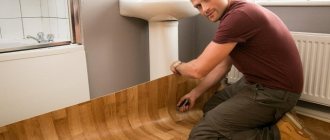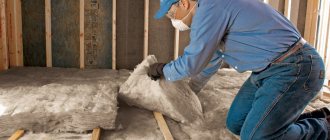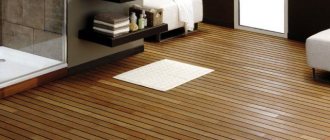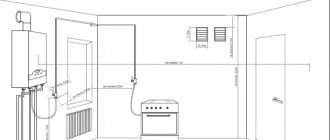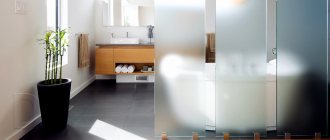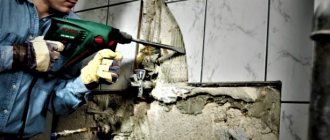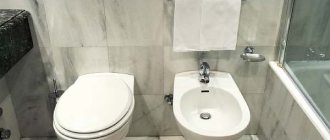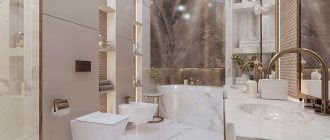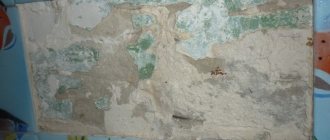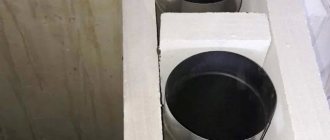Before you think about finishing a bathtub, you need to understand what features this room has that can affect its finishing. Most people have tiles in their bathrooms, which is considered the norm, and other options are not considered. The reason for this phenomenon is obvious - very high humidity, and other finishing materials do not last long in such an environment. Due to high moisture, droplets of water regularly appear on the surface of the walls in the bathroom, making the entire wall wet.
Why decorative plaster?
Who would want to use plaster on walls that are constantly covered in water? Decorative plaster for the bathroom appeared relatively recently and slowly began to be used in apartments. Special mixtures have all the necessary properties so that they can be used in the bathroom. Here are the main characteristics of decorative plasters that are used when decorating a bathroom:
- Good moisture resistance
- High vapor permeability
- Lack of conditions for the development of mold and mildew
- Formation of a favorable microclimate
The best option for finishing a bathroom is to use Venetian plaster. This is a waterproof decorative plaster that creates a marble effect. But not only Venetian has the necessary properties; there is much more choice on the market.
It is worth paying attention to the so-called textured plasters. With their help, you can obtain a variety of reliefs on the surface being treated. It’s worth noting right away that in this case the wall will not be smooth, and washing it will be problematic. In fact, you can choose any textured plaster from the existing ones, the main thing is that it is waterproof.
If we talk about the ability of materials to withstand an aggressive environment, then it would not hurt to turn your attention to facade decorative plaster. It is specially designed to withstand very harsh weather conditions, so it can cope with the climate in the bathroom. Facade moisture-resistant decorative plaster can be used in the bathroom if you are not picky about the appearance of the walls. You won’t be able to create any interesting or original patterns with this material, so it is extremely rarely used for such purposes.
The ideal option for a bathroom would be to use a solution that creates a smooth texture. Such a surface can always be polished to a shine, and then covered with a protective layer of varnish or wax. After this, the decorative plaster you choose for bathrooms will last much longer. Venetian plaster is best suited for this role.
Using sanitizing plaster
The concept of sanitizing plasters includes materials that are used to treat walls that come into contact with water. We are not just talking about the bathroom, because it can be used in the pool or basement. Sanitizing plaster can be used as a substrate and should be used even if you decide to lay tiles in the bathroom. This is not the moisture-resistant decorative plaster for the bathroom that many people think about. It doesn’t have any special decorative effects, but it perfectly resists excess moisture. It is better to apply the sanitizing plaster itself in a layer of 1 cm. It will dry in 1 week, and a thicker layer will dry up to three weeks.
How to make a rough “bark beetle” coating with your own hands
To create such a coating, small granules are added to the finishing mixture.
Plaster the walls like this:
- A base coat is applied over the rough layer. It is leveled using the rule, eliminating protrusions.
- After the base has partially set, plaster with granules is applied. The dried surface is treated with a construction float. The granules scratch the coating, forming indentations. Hand movements create the desired pattern.
You can see in the photo what the surface will look like after finishing.
Choosing the right texture for the bathroom
The classic structural plaster is “bark beetle”. There are other options, but they are not as popular. However, even if the material you choose is suitable for a bath, we still do not recommend using it if we are talking about bark beetle. Decorative plaster on the walls in the bathroom will not protect you from the hassle of cleaning them in the future. A month, a year or five years will pass, but the issue of dirty walls will come up. The walls in the bathroom become dirty due to natural reasons and will have to be washed. Plaque due to contact with water will cause particular problems.
If you have washed tiles, then you know how good it is when the surface is smooth. But with the “bark beetle” structure and others like it, there is no need to talk about simplicity. Of course, the protruding layer will be washed, but all the depressions will remain dirty, and the wall will change its color. It’s another matter if after applying decorative plaster you get a smooth wall. This surface is easier to clean, which is also important when choosing decorative plaster for the bathroom. Of course, it’s up to everyone, but it doesn’t hurt to know all the pros and cons.
Another important advantage of the smooth surface is the ability to use a variety of suction cups for fastening. Of course, you can hang hooks and soap dishes on dowels, but with suction cups it’s somehow aesthetically pleasing. You will not be able to attach them to a rough surface. If you have a child, you can periodically cover the walls with decorative stickers, which are easily removed and do not leave marks on the surface.
How to prepare a wall for applying liquid wallpaper?
How to prepare walls for liquid wallpaper
- First remove old layers of paint and plaster. ...
- Also get rid of elements sticking out from the walls: nails and other parts.
- Be sure to treat fittings or pipes that cannot be removed: you can put a 2 mm layer of putty on top or cover them with oil paint.
18 Feb
2022 Interesting materials:
Do I need to notify the Pension Fund about a change of registration in Ukraine? Do you need to cook boletus mushrooms? Should you cook broccoli before freezing? Do you need to cook butter? Do you need to cook boletus mushrooms? Do you need to boil boletus and boletus mushrooms before frying? Do you need to boil saffron milk caps before salting? Do you need to cook fresh champignons? Do you need to boil cauliflower before frying? Do I need to make a salary change on the T2 card?
Features of the work
There is no point in describing all the options for applying decorative plaster in the bathroom, because they significantly depend on the material you choose. And this concerns not only the form in which the plaster is produced, but also the composition and other characteristics. You need to know that the surface is thoroughly cleaned, leveled, primed, plastered and covered with a protective layer. This is the basic procedure, which is adjusted depending on the selected material.
Decorative plaster in the bathroom is applied in the same way as in any other room. It is important to understand here that the decisive role is played by the properties of the material, and not the technique of its application. This can be a dry plaster that needs to be diluted with water, or in the form of a thick paste that can be applied immediately. This does not play a decisive role. Although ready-to-use decorative plaster would be preferable to make the work easier.
Each plaster has its own characteristics, from drying time to the thickness of the applied layer and their number. The same “Venetian” can be applied up to 12 layers to create the effect of decorative stone. Moreover, you can create a decorative piece in the bathroom from two parts, and you will have two different patterns or shades.
To do this, when working, use masking tape as a demarcation line. Just stick it on the place where you will have the transition. Plaster one section of the wall, applying a layer of masking tape, and then tearing it off. You will get a straight transition line. You process the second part of the wall in the same way. This way you can make as many transitions as you like so that the wall is not uniform.
Protective wax to extend service life
Moisture-resistant decorative plaster for the bathroom is a good choice, but you cannot rely on it alone, thinking that it will be enough. Even though we are talking about a moisture-resistant material with increased resistance to physical stress, it still needs protection. Ideally, you need to cover the surface with wax, which will add water-repellent properties to it, and it will be very convenient to wash the wall. However, in this case we need a smooth surface, as described above. The wax coating will make the wall shinier and more durable.
Pros and cons of finishing
Advantages and disadvantages of decorative plaster.
| pros | Minuses |
| This decorative finish is moisture-resistant, fire-resistant, environmentally friendly, non-toxic and has good antistatic properties. | It has a rather complex application that cannot be handled without the help of professionals. |
| It has high vapor permeability, which allows you to create a favorable microclimate in the room and does not imply the development of fungus. | |
| The material is well washable and fairly easy to care for. | It is also difficult to dismantle. |
| Due to the huge number of colors, shades, the ability to imitate various materials and create a relief patterned surface, this decorative finish allows you to create a unique design. |
Decorative plaster in the bathroom - positive and not so positive reviews
For your convenience, reviews about decorative plaster in the bathroom from all over the Internet have been collected in one place. However, it is worth understanding that people use various materials, not just Venetian plaster.
We chose Venetian plaster because we always wanted to have marble walls in the bathroom. We preferred the Tikkurila brand. I had to struggle with leveling the walls. For Venetian decorative plaster, as they explained to us in the store, perfectly smooth walls are required. Then there was some fuss with the tinting, but we got the desired shade. Instructions for work were on the package, so we did without a technician. When the neighbor saw what had happened to our bathroom, envy ate her up from the inside.
Friends advised us to use Venetian plaster for the bathroom, so we did just that. They applied it in 7 layers, which was quite hard on the pocket. However, it's worth it. The walls are easy to clean and the color remains the same. Three years later, it seems like the plaster was applied just yesterday. The ceiling was also treated with Venetian plaster. Now you can lie in the bathroom and have fun, looking at the ceiling and walls.
Two years ago I used decorative Venetian plaster in the bathroom. It’s beautiful on the outside, but what’s most important for me is that mold doesn’t form in wet places (joints between the bathroom and the wall). In those places where the wall is constantly in contact with water, there are no streaks. A large amount of protective wax helps.
I thought for a long time about decorations for the bathroom, and in the end I decided to cover the walls that come into contact with water with tiles. Still, the method is proven and reliable. But the other half of the room has already been given over to plaster. It looks good, and you don’t have to worry that in a year the plaster will float or mold will appear. Plaster is not marble, but only its imitation.
For the bathroom, definitely use only Venetian decorative items. It consists of marble chips and an acrylic binder. This allows you to create water resistance, but only temporarily. Yes, such a wall can be washed frequently, and there is no fear that condensation from steam will appear on it or minor splashes will get on it. What’s worse is regular contact with water, and the Venetian is not designed for this. It is clear that a layer of wax will significantly improve the waterproof properties of the material and also extend its life. But wax does not last forever, in small quantities, but it is washed off. So there is only one way out: hire a professional who will perfectly level the wall, apply the Venetian perfectly, cover it with wax perfectly, and also occasionally renew the wax coating.
Care
Only after a month can we say that the drying process is complete: the material has acquired its characteristic stability. This is a feature of Venetian plaster.
During the transition period, it is important to be careful about the work done. Avoid splashing water on the walls.
You can treat the surface with a damp sponge. Dirty places are “removed” with detergents. The use of solvents and/or hard scourers and abrasive powders is unacceptable.
Decorative plaster: photos of bathrooms
Repairing a toilet separate from the bathroom
Decorative plaster can also be used to renovate a toilet. Moreover, it is not very important whether your bathroom is combined or separate. However, we will consider the option when the toilet and bath are separate rooms. In this case, there will be no strong steam and high humidity in the toilet due to the shower. So applying decorative plaster in the toilet with your own hands is very simple.
In fact, the same requirements are put forward to the toilet as to the bathroom, with the exception of problems with high humidity (some toilets have a problem with moisture and condensation from pipes). Finishing the walls in the toilet with decorative plaster gives you the following advantages:
- The walls are insulated from moisture and absorb excess moisture if present.
- In case of flooding by neighbors, the plaster will not come off like wallpaper.
- Aesthetic qualities.
Sometimes people prefer to decorate not only the walls, but also the ceiling in the toilet. Moreover, they choose Venetian plaster. Yes, the material is expensive, but the area of the room is very small, so such expenses are acceptable. In the case of the Venetian, you will have something to look at in the toilet (both walls and ceiling) during your stay there.
Advantages
It represents a relatively new trend in the design of interiors and exteriors, although textured plaster is essentially the same as the well-known decorative plaster. The name is due to the fact that the liquid or dry mixture contains various additives (crumbs of artificial and natural minerals, fibers, etc.), which allow you to create a unique texture.
For example, stone plaster imitates natural stone, Venetian plaster imitates marble. You can add originality using ordinary construction tools, such as a spatula or various stencils.
Another original design option
The popularity of plaster is based on the possibility of a wide variety of design solutions for finishing. Manufacturers offer a wide selection of colors and textures. They can be selected from the catalogue. Mixtures are sold ready-to-use in color, and those that can be painted immediately before application to the wall.
Plaster is plastic. She is easy to work with. Moreover, a person who does not have professional construction skills can plaster without much difficulty.
- The material is resistant to mechanical and temperature influences. In particular, it can withstand temperatures from -50 to +75 degrees. These qualities ensure a long service life of the plaster.
- Such plaster, as professionals say, breathes. It means that
- the material is able to absorb excess moisture in the air, retain it, and release it back without losing its functional properties.
- The plaster coating is easy to care for. Dirt and soap drips are easily removed from it.
- Easily repairable.
